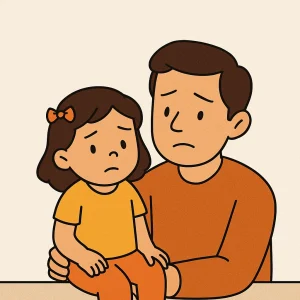Finding the Perfect Level of Parental Involvement in Online Therapy
Last Updated: June 10, 2025
In recent years, online therapy has become increasingly popular, offering a convenient and accessible way for children to receive the support they need. This shift has brought new dynamics to the therapy process, particularly when it comes to parental involvement. As a parent, you play a crucial role in your child’s therapeutic journey. Your engagement can significantly influence the effectiveness of the therapy, but it’s essential to strike the right balance.
Too much involvement can sometimes hinder the child’s progress, while too little can leave them feeling unsupported. So, how do you find the perfect level of involvement? This article will guide you through understanding the importance of parental involvement in online therapy and help you discover how to maintain that delicate balance for the best possible outcomes.
Free Speech Help for Kids
Concerned about speech delays? Book a free consultation with our expert speech therapist and get guidance tailored to your child’s needs.
Understanding Parental Involvement in Online Therapy
Defining Parental Involvement in Online Therapy
Parental involvement in online therapy means that parents actively take part in their child’s therapy sessions, even though these sessions happen virtually. This can include being present during the sessions, helping the child stay engaged, and applying what they learn in daily life. In online therapy, parents often need to provide extra support to ensure their child benefits fully from the sessions.
Role of Parents in Traditional Therapy vs. Online Therapy
In traditional therapy, parents usually have a less active role, with therapists leading the sessions in person and children participating on their own. In online therapy, however, parents may need to be more involved. They might help set up the session, keep the child focused, and sometimes even assist with the activities. This shift can be empowering but also challenging, so it’s important for parents to learn how to adapt their involvement effectively.
Benefits of Parental Involvement
Being involved in online therapy offers several benefits that can make the therapy more effective:
- Emotional Support: When parents are involved, children often feel more comfortable and secure, which helps them open up and engage better during therapy.
- Guidance: Parents can help reinforce what the child learns during therapy by practicing the techniques at home, leading to better and faster progress.
- Reinforcement of Therapy Techniques: By being involved, parents learn the same techniques as the therapist, allowing them to reinforce these methods at home. This consistency helps solidify the child’s progress and supports long-term improvement.
The Importance of Balance
Why Finding the Right Level of Involvement is Crucial
While parental involvement is beneficial, finding the right balance is crucial. Too much or too little involvement can impact the effectiveness of the therapy and the child’s overall development. The goal is to support your child without overshadowing their individual progress.
Risks of Over-Involvement
- Possible Dependency: Over-involvement can lead to a child becoming overly dependent on their parents during therapy sessions. This dependency might hinder their ability to develop independence and confidence in managing their emotions and behaviors.
- Reduced Independence: When parents are too involved, children might struggle to take ownership of their progress. This can reduce their motivation to engage with therapy independently, which is a crucial aspect of their growth and development.
Risks of Under-Involvement
- Lack of Support: On the other hand, under-involvement can leave a child feeling unsupported and isolated in their therapeutic journey. Without parental guidance, they may struggle to apply the techniques learned in therapy to their everyday life.
- Missed Opportunities for Reinforcement: Parents who are not sufficiently involved may miss out on reinforcing the therapy techniques at home, which can slow down the child’s progress. The lack of reinforcement can lead to inconsistency in applying therapy strategies, reducing the overall effectiveness of the therapy.
Factors Influencing the Level of Involvement
Child’s Age and Developmental Stage
As children grow and develop, their needs and the level of parental involvement in therapy naturally change. For younger children, such as toddlers and preschoolers, parental involvement is often more hands-on. At this stage, parents are typically more involved in setting up the therapy environment, assisting with activities, and providing constant guidance and support.
As children mature, particularly during the school-age years, the need for direct parental involvement may decrease. However, parents still play a crucial role in reinforcing therapy techniques at home and providing emotional support. For teenagers, involvement shifts even further, focusing more on offering encouragement and ensuring the child remains engaged and motivated. Understanding your child’s developmental stage can help you adapt your level of involvement to meet their evolving needs.
Nature of the Therapy
Different types of therapy require varying levels of parental involvement. For instance, in speech therapy, especially when conducted online, parents may need to actively participate by helping their child practice speech exercises and encouraging the use of newly learned communication skills in everyday situations. Behavioral therapy, on the other hand, might require parents to observe and implement behavior management strategies at home, reinforcing positive behaviors and addressing challenges in real-time.
Each therapy type has unique demands, and understanding these can help you determine how best to support your child. Tailoring your involvement based on the nature of the therapy ensures that your child gets the most out of their sessions, whether it’s through direct participation or by creating a supportive home environment.
Child’s Individual Needs
Every child is unique, with their own set of strengths and challenges. Some children may thrive with more independence and minimal parental involvement, while others may need more consistent support and guidance. It’s essential to tailor your level of involvement to your child’s individual needs. For example, a child with anxiety might benefit from having a parent present during online therapy sessions to provide reassurance and help them stay focused.
Conversely, a child who is highly motivated and self-sufficient might do better with a more hands-off approach, allowing them to take ownership of their therapy journey. Regular communication with your child’s therapist can provide valuable insights into how much involvement is beneficial for your child and when it might be best to step back.
Age-Appropriate Parental Involvement
| Age Group | Parental Role | Suggested Activities |
|---|---|---|
| Toddlers (2-5 years) | Hands-on guidance and support | – Setting Up Sessions: Ensure the environment is distraction-free and conducive to therapy. – Assisting with Activities: Actively participate in therapy exercises, helping your child understand and engage with the activities. – Encouragement: Provide constant positive reinforcement to keep your child motivated and comfortable during the sessions. |
| School-age (6-12 years) | Guidance with growing independence | – Practicing Techniques: Regularly practice therapy techniques learned during sessions to reinforce progress. – Creating Routines: Establish consistent therapy routines that integrate into daily life, making therapy a regular part of the child’s day. – Positive Reinforcement: Use praise and rewards to encourage the use of therapy techniques in everyday situations. |
| Teens (13+ years) | Support with independence | – Encouraging Self-Advocacy: Empower your teen to communicate their needs and preferences in therapy. – Discussing Therapy Goals: Involve your teen in setting and reviewing therapy goals, fostering a sense of ownership over their progress. – Providing Space: Gradually step back to allow your teen to take more responsibility while remaining available for support and guidance. |
Best Practices for Effective Parental Involvement
Communicating with the Therapist to Understand Your Role
Effective parental involvement begins with clear and open communication with your child’s therapist. Start by discussing your role in the therapy process, asking questions about how you can best support your child’s progress. Each therapy session may require different levels of involvement, so it’s important to stay informed about what’s expected of you. Regular check-ins with the therapist can help you stay aligned with the therapy goals and ensure that your involvement is both appropriate and beneficial.
Questions like “What can I do to reinforce today’s session at home?” or “How can I support my child’s progress between sessions?” are great ways to clarify your role. The therapist can provide guidance on specific strategies and activities that can be implemented at home, ensuring that your involvement is meaningful and supportive.
Tips for Reinforcing Therapy Techniques at Home
One of the most impactful ways to be involved in your child’s therapy is by reinforcing the techniques they learn during their sessions at home. This might include practicing speech exercises, implementing behavior management strategies, or engaging in activities that build on the skills being developed in therapy. Consistency is key—regular practice can help your child make steady progress and feel more confident in applying what they’ve learned.
Make these activities a natural part of your daily routine. For example, incorporate speech exercises into conversations during meal times, or use behavioral techniques during playtime. The goal is to create a supportive environment where therapy becomes a seamless part of everyday life, rather than a separate task.
Setting Boundaries: Knowing When to Step Back
While it’s important to be involved, it’s equally crucial to know when to step back and allow your child to develop independence. Over-involvement can sometimes lead to dependency, where your child relies too heavily on your presence during therapy sessions. To prevent this, work with the therapist to identify moments when it’s appropriate to take a step back and let your child take the lead.
For instance, as your child becomes more comfortable with therapy techniques, gradually reduce your direct involvement, encouraging them to practice on their own. This approach helps foster independence and builds your child’s confidence in managing their progress. Setting boundaries doesn’t mean withdrawing support entirely—it’s about finding the right balance between guidance and independence, ensuring that your child feels both supported and empowered.
Challenges in Maintaining the Right Level of Involvement
Balancing Involvement with Other Responsibilities
One of the most significant challenges parents face in maintaining the right level of involvement in their child’s online therapy is balancing it with other responsibilities. Whether it’s managing a full-time job, caring for other children, or handling daily household tasks, finding the time and energy to be involved in therapy sessions can be overwhelming. It’s important to acknowledge that you’re doing your best and that it’s okay to seek help or delegate tasks when needed.
Creating a structured routine that incorporates therapy sessions and practice times can help make involvement more manageable. Prioritizing tasks and setting realistic goals for your level of involvement can reduce stress and ensure that your child continues to receive the support they need, even when life gets busy.
Dealing with Emotional Challenges
Emotional challenges such as anxiety, frustration, or guilt are common among parents who are trying to support their child’s therapy. You might feel anxious about whether you’re doing enough or frustrated when progress seems slow. Guilt can also creep in, especially when you feel that you’re not as involved as you should be due to other commitments.
It’s essential to recognize these feelings and understand that they are a normal part of the process. Speaking openly with your child’s therapist about your concerns can provide reassurance and guidance on how to manage these emotions. Remember, taking care of your emotional well-being is just as important as supporting your child’s therapy journey. It’s okay to take breaks and give yourself grace during challenging times.
Managing Differing Opinions Between Parents and Therapists
Another challenge that may arise is managing differing opinions between parents and therapists regarding the appropriate level of involvement. It’s not uncommon for parents to feel more or less involved than what the therapist recommends. This difference in opinion can lead to confusion or even tension.
Open and respectful communication is key to resolving these differences. Express your concerns and listen to the therapist’s perspective. Together, you can find a compromise that works best for your child’s needs. It’s important to trust the therapist’s expertise while also advocating for what you believe is in your child’s best interest. The goal is to work collaboratively to create a supportive environment that fosters your child’s progress.
Conclusion
Finding the right balance in how you support your child’s online therapy is essential for their success. By staying involved, informed, and flexible, you can give your child the support they need while also helping them become more independent. Your role as a parent may change over time, so it’s important to keep up with your child’s needs and follow the guidance of their therapist.
You don’t have to do it all alone. Resources like Wellness Hub can help by offering tools, insights, and advice to guide you. By using these resources, you can make sure that your involvement is helpful and in line with your child’s therapy goals. Remember, your ongoing dedication and willingness to adapt will make a big difference in your child’s progress.
Frequently Asked Questions:
1. Why is parental involvement important in online therapy?
Parental involvement in online therapy is crucial because it provides emotional support, reinforces therapy techniques at home, and helps children feel secure during their sessions. Parents play a vital role in ensuring the therapy is effective and that progress is made.
2. How can I find the right balance in my involvement in my child’s therapy?
Finding the right balance involves staying engaged and informed while also allowing your child to develop independence. It’s important to communicate regularly with the therapist and adjust your level of involvement as your child’s needs change.
3. What are the risks of being too involved in my child’s online therapy?
Over-involvement can lead to your child becoming too dependent on you, which may hinder their ability to develop independence and self-confidence. It’s essential to step back when necessary and let your child take the lead in their therapy.
4. How can I support my child’s therapy at home?
You can support your child’s therapy by reinforcing the techniques they learn during sessions, incorporating therapy activities into your daily routine, and maintaining a positive and encouraging environment at home.
5. How do I manage differing opinions between myself and my child’s therapist?
Managing differing opinions involves open communication and collaboration with the therapist. Express your concerns, listen to the therapist’s perspective, and work together to find a solution that best supports your child’s progress.
6. What should I do if I feel overwhelmed with my responsibilities in my child’s therapy?
If you feel overwhelmed, it’s important to seek support, whether from family, friends, or professional resources like Wellness Hub. Prioritize tasks, set realistic goals, and remember that it’s okay to ask for help when needed.
7. How can I help my older child or teen take an active role in their therapy?
Encourage self-advocacy by involving your older child or teen in their therapy decisions, helping them understand their therapy goals, and encouraging them to communicate openly with their therapist. This empowerment helps them take ownership of their progress.
8. What are the best practices for parental involvement in online therapy?
Best practices include maintaining regular communication with the therapist, being flexible in your involvement as your child progresses, and encouraging your child to develop independence and self-advocacy skills.
9. How can Wellness Hub support my involvement in my child’s therapy?
Wellness Hub offers a range of resources, tools, and professional advice to help parents navigate their involvement in their child’s online therapy. These resources can guide you in providing the most effective support for your child’s therapy journey.
10. How does my child’s age affect how much I should be involved in their online therapy?
Your child’s age affects how much you should be involved in their online therapy. Younger children may need more help from you, like setting up the session and guiding them through activities. As they get older, you can step back a bit and focus more on encouraging them and helping them practice what they learn, while letting them take more responsibility for their progress.
About Author:
Lasya Vooturi
Clinical Psychologist (A) and Behavioral Therapist
Lasya holds a Professional Diploma in Clinical Psychology from Amity University, where she deepened her understanding of psychological principles from March 2023 to March 2024. With over a year of dedicated experience as a Behavioral Therapist, Lasya has honed her skills in applying effective therapy techniques tailored to individual needs. Fluent in Telugu, Hindi, and English, she is adept at connecting with a diverse range of clients, ensuring comprehensive communication and understanding. Lasya’s approach is grounded in empathy and scientific rigor, making her a trusted ally in navigating mental health challenges.
Book your Free Consultation Today
Parent/Caregiver Info:
Client’s Details:
* Error Message









